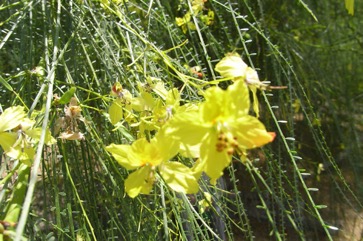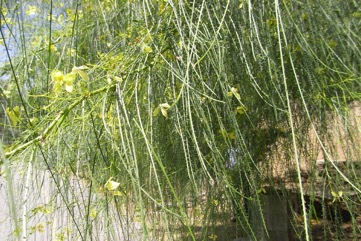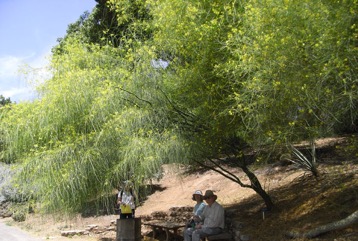Jerusalem thorn

A tropical and subtropical plant. It is native from Mexico to Honduras. It grows in warm subtropical and tropical places. It suits semi-arid places. It grows in areas with a rainfall between 200-1,000 mm per year. It grows along drainage lines and on flood plains. It grows in dry lowland grassland and coastal regions. It grows in the Sahel. In East Africa it grows from sea level to 1,400 m above sea level. It can grow in alkaline and salty soils. It can grow in arid places. It suits hardiness zones 9-11.
Also known as:
Adanti, Balati kikar, Barbados flower fence, Cemaraan, Cina cina, Espinillo, Garabato, Geed walaayo, Kim tuoc chi, Kunto-barbariae, Mexican palo verde, Muk-bee, Mya-sein, Myinsa-goni, Okwato, Palo verde, Pardeshi baval, Parkinsonia, Ram baval, Ratamah, Ratta-maa, Retamo rojo, Retma, Sima tumma, Vilayati babul, Vilayati kikar
Synonyms
- Parkinsonia thornberi M. E. Jones
- Cercidium
Edible Portion
- Seeds - coffee, Seeds, Flowers, Fruit, Leaves
Where does Jerusalem thorn grow?
Found in: Afghanistan, Africa, Angola, Antilles, Asia, Argentina, Australia, Bahamas, Bangladesh, Bolivia, Botswana, Brazil, Burkina Faso, Cameroon, Cape Verde, Central Africa, Central America, Chad, Chile, China, Colombia, Congo, Costa Rica, Cuba, Cyprus, Dominican Republic, East Africa, Ecuador, Egypt, El Salvador, Eritrea, Eswatini, Ethiopia, Galapagos, Ghana, Guadeloupe, Guatemala, Guiana, Guianas, Guyana, Haiti, Hawaii, Honduras, India, Indochina, Indonesia, Iraq, Israel, Jamaica, Kenya, Lesser Antilles, Libya, Marquesas, Martinique, Mexico, Morocco, Mozambique, Myanmar, Namibia, Netherlands Antilles, New Caledonia, Nicaragua, Nigeria, North Africa, North America, Pacific, Pakistan, Panama, Paraguay, Peru, Puerto Rico, Sahel, SE Asia, Senegal, Sierra Leone, Slovenia, Somalia, South Africa, Southern Africa, South America, Sri Lanka, Sudan, Suriname, Swaziland, Tanzania, Thailand, Uganda, Uruguay, United States, Venezuela, Vietnam, West Africa, West Indies, Zimbabwe
Notes: There are (2-3) 12-29 Parkinsonia species. The thorns make it a weed problem. Also as Caesalpinaceae.
Status: The seeds are eaten especially by children.
Growing Jerusalem thorn
Cultivation: Plants are grown from seed. Seeds can be put in boiling water then allowed to cool down before planting. Seed can spread in flood waters. The seed are best sown fresh. Seedlings can be transplanted after 6-10 weeks. Plants can also be grown from root or stem cuttings and air-layering. Plants can be used to form hedges. They can be cut back and will re-grow.
Edible Uses: The immature seeds are eaten raw. Ripe seeds are roasted and ground and used as a coffee substitute. The seeds are also parched, sun dried and cooked and eaten. The fruit pulp is sweet and edible.
Production: It grows quickly.
Nutrition Info
per 100g edible portion| Edible Part | Energy (kcal) | Protein (g) | Iron (mg) | Vitamin A (ug) | Vitamin c (mg) | Zinc (mg) | % Water |
|---|---|---|---|---|---|---|---|
| - | - | - | - | - | - |
Jerusalem thorn Photos




References
Addis, G., et al, 2005, Ethnobotanical Study of Edible Wild Plants in Some Selected Districts of Ethiopia. Human Ecology, Vol. 33, No. 1, pp. 83-118
Addis, G., Asfaw, Z & Woldu, Z., 2013, Ethnobotany of Wild and Semi-wild Edible Plants of Konso Ethnic Community, South Ethiopia. Ethnobotany Research and Applications. 11:121-141
Addis, G., et al, 2013, The Role of Wild and Semi-wild Edible Plants in Household Food Sovereignty in Hamer and Konso Communities, South Ethiopia. Ethnobotany Research & Applications. 11:251-271
Ambasta, S.P. (Ed.), 2000, The Useful Plants of India. CSIR India. p 430
Asfaw, Z. and Tadesse, M., 2001, Prospects for Sustainable Use and Development of Wild Food Plants in Ethiopia. Economic Botany, Vol. 55, No. 1, pp. 47-62
Bahru, T., et al, 2013, Wild Edible Plants: Sustainable Use and Management by Indigenous Communities in and the Buffer Area of Awah National Park, Ethiopia. Ethiop. J. Sci., 36(2): 93-108
Barwick, M., 2004, Tropical and Subtropical Trees. A Worldwide Encyclopedic Guide. Thames and Hudson p 311
Bekele-Tesemma A., Birnie, A., & Tengnas, B., 1993, Useful Trees and Shrubs for Ethiopia. Regional Soil Conservation Unit. Technical Handbook No 5. p 342
Bodkin, F., 1991, Encyclopedia Botanica. Cornstalk publishing, p 762
Brickell, C. (Ed.), 1999, The Royal Horticultural Society A-Z Encyclopedia of Garden Plants. Convent Garden Books. p 751
Burkill, H. M., 1985, The useful plants of west tropical Africa, Vol. 3. Kew.
Condit, R., et al, 2011, Trees of Panama and Costa Rica. Princeton Field Guides. p 182
Cooper, W. and Cooper, W., 2004, Fruits of the Australian Tropical Rainforest. Nokomis Editions, Victoria, Australia. p 106
Cundall, P., (ed.), 2004, Gardening Australia: flora: the gardener's bible. ABC Books. p 987
Dharani, N., 2002, Field Guide to common Trees & Shrubs of East Africa. Struik. p 141
Dunlop, C.R., Leach, G.J. & Cowie, I.D., 1995, Flora of the Darwin Region. Vol 2. Northern Territory Botanical Bulletin No 20. p 34
Engel, D.H., & Phummai, S., 2000, A Field Guide to Tropical Plants of Asia. Timber Press. p 162
Etherington, K., & Imwold, D., (Eds), 2001, Botanica's Trees & Shrubs. The illustrated A-Z of over 8500 trees and shrubs. Random House, Australia. p 511
Flora of Australia Volume 12, Mimosaceae (excl. Acacia) Caesalpiniaceae. Melbourne: CSIRO Australia (1998) p 69
Flora of Pakistan. www.eFlora.org
Grandtner, M. M., 2008, World Dictionary of Trees. Wood and Forest Science Department. Laval University, Quebec, Qc Canada. (Internet database http://www.wdt.qc.ca)
Grandtner, M. M. & Chevrette, J., 2013, Dictionary of Trees, Volume 2: South America: Nomenclature, Taxonomy and Ecology. Academic Press p 483
Grubben, G. J. H. and Denton, O. A. (eds), 2004, Plant Resources of Tropical Africa 2. Vegetables. PROTA, Wageningen, Netherlands. p 563
Hahn, K., et al, 2018, The Use of Wild Plants for Food: a National Scale Analysis for Burkina Faso (West Africa) Flora et Vegetatio Sudano-Sambesica 21, 25-33
Hall, N. et al, 1972, The Use of Trees and Shrubs in the Dry Country of Australia, AGPS, Canberra. p 394
http://www.botanic-gardens-ljubljana.com/en/plants
Hussey, B.M.J., Keighery, G.J., Cousens, R.D., Dodd, J., Lloyd, S.G., 1997, Western Weeds. A guide to the weeds of Western Australia. Plant Protection Society of Western Australia. p 124
Kenneally, K.E., Edinger, D. C., and Willing T., 1996, Broome and Beyond, Plants and People of the Dampier Peninsula, Kimberley, Western Australia. Department of Conservation and Land Management. p 76
Kermath, B. M., et al, 2014, Food Plants in the Americas: A survey of the domesticated, cultivated and wild plants used for Human food in North, Central and South America and the Caribbean. On line draft. p 608
Krishen P., 2006, Trees of Delhi, A Field Guide. DK Books. p 281
Lamp, C & Collet F., 1989, Field Guide to Weeds in Australia. Inkata Press. p 201
Llamas, K.A., 2003, Tropical Flowering Plants. Timber Press. p 205
Lord, E.E., & Willis, J.H., 1999, Shrubs and Trees for Australian gardens. Lothian. p 63
Loughmiller, C & L., 1985, Texas Wildflowers. A Field Guide. University of Texas, Austin. p 134
Mahony, D., 1991, Trees of Somalia. A Field Guide for Development Workers. Oxfam Research Paper 3. p 9
Malezas Comestibles del Cono Sur, INTA, 2009, Buernos Aires
Maydell, H. von, 1990, Trees and shrubs of the Sahel: their characteristics and uses. Margraf. p 343
Mbuya, L.P., Msanga, H.P., Ruffo, C.K., Birnie, A & Tengnas, B., 1994, Useful Trees and Shrubs for Tanzania. Regional Soil Conservation Unit. Technical Handbook No 6. p 380
McMakin, P.D., 2000, Flowering Plants of Thailand. A Field Guide. White Lotus. p 23
Milson. J., 2000, Trees and Shrubs of north-west Queensland. DPI p 22
Moerman, D. F., 2010, Native American Ethnobotany. Timber Press. p 377
Paczkowska, G. & Chapman, A.R., 2000, The Western Australian Flora. A Descriptive Catalogue. Western Australian Herbarium. p 191
Palgrave, K.C., 1996, Trees of Southern Africa. Struik Publishers. p 289
Plants of Haiti Smithsonian Institute http://botany.si.edu/antilles/West Indies
Petheram, R.J. and Kok, B., 2003, Plants of the Kimberley Region of Western Australia. UWA Press p 511
Pham-Hoang Ho, 1999, An Illustrated Flora of Vietnam. Nha Xuat Ban Tre. p 846
Pullaiah, Y., Krishnamurthy, K. V. & Bahadur, B., (Eds.), 2016, Ethnobotany of India, Volume 1: Eastern Ghats and Deccan.
Royal Botanic Gardens, Kew (1999). Survey of Economic Plants for Arid and Semi-Arid Lands (SEPASAL) database. Published on the Internet; http://www.rbgkew.org.uk/ceb/sepasal/internet [Accessed 21st April 2011]
Sp. pl. 1:375. 1753
Staples, G.W. and Herbst, D.R., 2005, A tropical Garden Flora. Bishop Museum Press, Honolulu, Hawaii. p 334
Swaminathan, M.S., and Kochnar, S.L., 2007, An Atlas of Major Flowering Trees in India. Macmillan. p 124
Swaziland's Flora Database http://www.sntc.org.sz/flora
Wheeler, J.R.(ed.), 1992, Flora of the Kimberley Region. CALM, Western Australian Herbarium, p 350
www.worldagroforestrycentre.org/treedb/